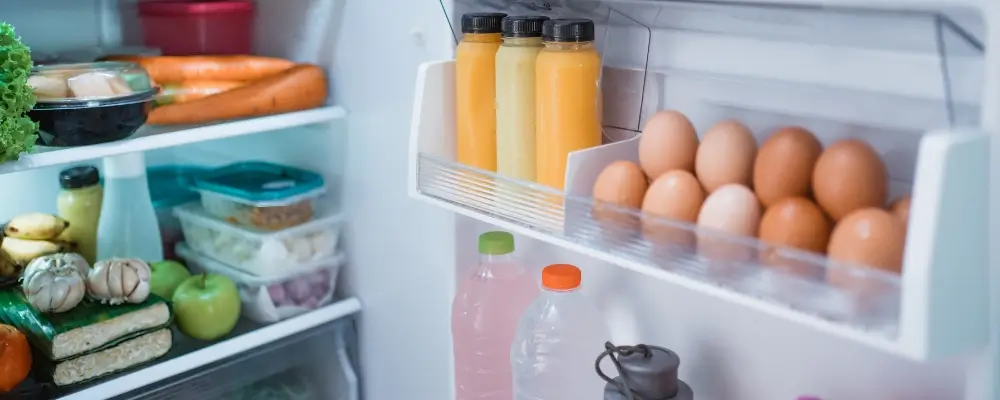Your refrigerator might seem like a simple haven for food, but it plays a crucial role in safeguarding your health. Improper storage can lead to rapid bacterial growth, making your meals a potential source of illness. To maximize food safety and freshness, it’s time to rethink the way you organize your fridge. Here are 10 practical tips to transform your fridge into a food safety fortress.
10 Effective Tips On Fridge Storage For Food Safety
Storing food in the fridge correctly is crucial for maintaining its freshness and ensuring food safety. Here are 10 practical tips for fridge storage to keep your food safe and fresh longer:
1. Temperature is Key
- The Danger Zone: Between 40°F (4°C) and 140°F (60°C), bacteria multiply rapidly. Keeping your fridge below 40°F significantly slows this growth, reducing the risk of foodborne illness.
- Monitor and Maintain: A fridge thermometer helps you track the temperature. Ideally, it should stay at or below 40°F (4°C) throughout. Adjust the fridge setting if needed, and consider placing a thermometer on each shelf to identify any temperature variations within the fridge.
2. Zone Out for Safety
- Contain Raw Drips: Raw meat, poultry, and seafood can contain harmful bacteria. Storing them on the bottom shelf in sealed containers prevents leaks or drips from contaminating other foods. This is especially important to avoid cross-contamination with ready-to-eat items.
- Cooked Food Sanctuary: Cooked meals, leftovers, deli meats, dairy products, and opened containers benefit from cooler temperatures. The upper shelves provide a safe haven for these items.
- Crisper Care: Most fruits and vegetables have specific humidity requirements to stay fresh. Many refrigerators have designated drawers with adjustable humidity control. Leafy greens might prefer higher humidity, while some fruits might not. Consult your fridge manual or produce storage guides for optimal settings.

3. Avoid Overcrowding
- Airflow is Essential: Cold air must circulate freely to maintain consistent temperatures throughout the fridge. Overcrowding restricts airflow, creating temperature pockets and hindering proper cooling. Leave some space between items for optimal air circulation.
4. Smart Containers
- Freshness and Spill Control: Airtight containers are your best friends for fridge storage. They minimize air exposure, which helps food retain moisture and freshness. They also prevent spills and leaks, contain any mess, and keep your fridge clean. Opt for BPA-free plastic or glass containers for safe and sustainable storage solutions.
- Ditch the Can: Opened cans expose food to air and potential contamination. Transfer leftover canned goods to airtight containers to maintain quality and safety.
5. Date and Rotate
- FIFO for Freshness: First In, First Out (FIFO) is a golden rule for fridge organization. Consume older items before opening newer ones. This helps prevent food spoilage and waste.
- Labeling is Key: Leftovers are notorious for lingering in the fridge. Labeling containers with the date you cooked the food helps you keep track and ensures you consume them before they spoil.
6. Cleaning Spills
- Prompt Action: Spills in the fridge can create breeding grounds for bacteria. Clean up spills immediately to prevent them from spreading and contaminating other foods. Use warm, soapy water or a disinfectant solution recommended for refrigerator cleaning.
7. Thawing Safely
- Slow and Steady Wins the Race: The safest way to thaw frozen food is in the refrigerator. This allows for a slow, controlled thaw that keeps the food out of the temperature danger zone for an extended period. Never thaw food on the counter at room temperature, creating a perfect environment for bacterial growth.

8. Don’t Cross-Contaminate
- Designated Cutting Boards: Raw meat can harbor bacteria. Use a separate cutting board for raw meat and poultry to prevent cross-contamination. This helps stop the spread of bacteria to other foods you might be preparing, like fruits and vegetables.
- Washing Hands is Crucial: After handling raw meat, poultry, or seafood, wash your hands thoroughly with warm, soapy water for at least 20 seconds to eliminate bacteria.
9. Know Your High-Risk Foods
- Extra Care Required: Certain foods require more vigilance due to their higher risk of spoilage or bacterial growth. These include eggs, dairy products, cooked rice, cut melons, sprouts, and pre-prepared meals. Store them at or below 40°F (4°C) and consume them within the recommended timeframes to ensure safety.
10. “When in Doubt, Throw it Out”
- Safety First: If you’re unsure about the safety of a particular food item, it’s always better to err on the side of caution and discard it. Look for signs of spoilage like foul odor, discoloration, or mold growth. Don’t risk consuming food that might be contaminated.
Conclusion
These simple tips aren’t just about keeping your food tasty – they’re about protecting your health and well-being. By making smart storage choices and taking a proactive approach to fridge organization, you minimize food spoilage, prevent foodborne illnesses, and create a haven for fresh, safe-to-eat meals. Let’s make food safety a priority in every kitchen!

